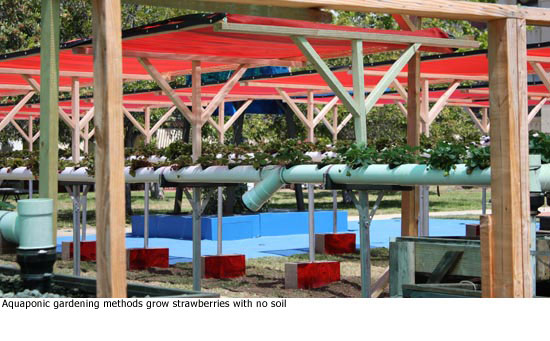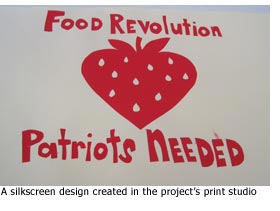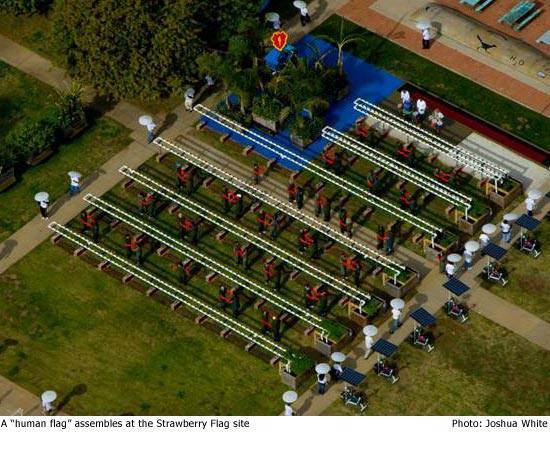Helping veterans, one berry at a time
May 27, 2010
Strawberry Flag is a living work of art. It’s also a social experiment, an adventure in aquaponic gardening, a village green, a place to ride a power-generating exercise bike, to silkscreen a T-shirt, to sample a raw food lunch—or to simply sit in a tent, sipping tea while nibbling an old-fashioned biscuit with hand-crafted jam.
Most powerfully of all, it’s a place where human beings are finding that great sustenance comes in small berries.
“To get to dig in the ground for me is a pleasure. To be close to the ground—to me, that’s close to God,” says Bobby Shelton, 75, an Army veteran who served in the Korean War and now is seeing action on the front lines of Strawberry Flag.
The experimental art installation on the grounds of the Veterans Administration campus in West Los Angeles is the brainchild of artist Lauren Bon, who, together with Dr. Jonathan Sherin of the VA, saw the possibility of creating a grand and evolving work on the site. The project is being funded by the Annenberg Foundation, by way of Bon’s Metabolic Studio.
Nestled on an all-but-forgotten quad on the VA grounds, the flag is made up of seven “stripes” of strawberries. The berries were rescued from an abandoned field in Rosemead and are now growing in pots set into white piping. Recycled and filtered L.A. River water pumps through the pipes, powered by a row of stationary bikes hooked up to batteries. At the top of the installation, light pours through cut-out stars onto a blue field, creating a restful shaded area.
Shelton’s specialty is tending to the ailing plants in the strawberry nursery. He’s got a life-giving touch; a thriving vegetable garden near the strawberries is a point of pride.
“It’s a wonderful project,” says Shelton, who takes the bus from his home near Inglewood to work at the flag six days a week. “I’ll be riding back and forth, telling people about it.”
Shelton does his job as part of the VA’s “compensated work therapy” program. So does Mel Williams, 59, an Air Force veteran who’s in charge of the onsite “vermiculture”—the process of using worms and their waste to create a compost tea that helps plants grow.
Williams has a two-hour commute to work each way from San Pedro, but you won’t hear any complaints.
 “I love this,” he says. “I’m being enriched with a lot of things here. I wake up and look forward to it…It gives me time to ponder what’s next.”
“I love this,” he says. “I’m being enriched with a lot of things here. I wake up and look forward to it…It gives me time to ponder what’s next.”
Bon, who lives in Topanga Canyon, said she was moved to create Strawberry Flag after the election of Barack Obama created an “imperative for the rest of us to rise to the occasion.”
“It makes sense to redefine what it means to be a patriot,” she says, “by growing a strawberry flag in the midst of under purposed buildings in the center of historic West Los Angeles.”
The artist, granddaughter of Walter Annenberg and a trustee of the Annenberg Foundation, is known for other works including Not A Cornfield near Chinatown in downtown L.A., in which she transformed an “industrial brownfield” into a cornfield. She’s also currently at work on a film project about the Owens Valley called “Silver and Water.”
Her land-use agreement with the VA ends in September. But she hopes to see some kind of continuing presence on the site that will keep the spirit of Strawberry Flag alive after she leaves.
Since it started last June, the project has grown quickly and organically.
There’s a Strawberry Flag Internet radio station, with programs put together in the gleaming Airstream trailer (also reclaimed and recycled) that serves as an on-site office. (A neon sign on the side of the trailer reads: GRAB A MOP.) A monthly newspaper, the Strawberry Gazette, is about to come out with its fourth issue. Strawberry Flag’s YouTube channel features a video chronicle of the project’s evolution.
The nearby VA buildings are being touched by the project’s vitality, too.
“It was a very different place when we came here last year,” says Rochelle Fabb, the project manager. “It was like a cemetery.”
One of the buildings now houses the project’s light-filled and inviting kitchen space. It’s where vets like Ruth Harris, Gregory Gauthier and Julio Espino work with newly-hired chef Gabriella Salamon, a raw food and healthy eating specialist, to learn the ins and outs of working with food grown on the site.
On Tuesdays, the kitchen serves up a healthy lunch after a “boot camp” workout on the stationary bikes. Wednesday afternoons are devoted to “jam sessions”—turning the strawberries and other fruits into preserves that are now proudly arrayed on shelves in the kitchen. Tea is served weekdays at 3 p.m., with a special High Tea offered once a month. (The next one is scheduled for 4 p.m. on June 10. Check Strawberry Flag’s Facebook page to RSVP.)
 In another nearby building, Larry Flaherty and Ray Rodgers preside over the print studio. Lining the table are vibrant silkscreen patterns that were transferred to T-shirts during a workshop. The studio also offers sessions in print-making and landscape painting to veterans, many of them first-time artists.
In another nearby building, Larry Flaherty and Ray Rodgers preside over the print studio. Lining the table are vibrant silkscreen patterns that were transferred to T-shirts during a workshop. The studio also offers sessions in print-making and landscape painting to veterans, many of them first-time artists.
“I thought it was magic when I saw what they could do with colors,” Flaherty says.
Rodgers points to their program’s “therapeutic value.” “I personally have gained people skills,” he says.
While Strawberry Flag is intended primarily for vets, it’s also open to the public, who are welcome to take part in any of the activities. (A map is here.)
On Monday, a Memorial Day drum circle is scheduled at the site from 7 p.m. to 8 p.m. to remember those who have served.
“If you have a drum, bring it,” Fabb says. If not, “we’ll have plenty of things here to bang.”
Sherin, the chief of mental health at the West Los Angeles VA campus who helped come up with the concept with “fellow Topangan” Bon, sees in Strawberry Flag a powerful metaphor for the veterans under his care.
“Strawberry plants provided a service. They were pulled out of the ground, retrieved and brought to this healing ground…The whole time this is happening, the veterans are doing the exact same thing—literally. Tending to [the strawberries] is quite a therapeutic experience.”
He, too, hopes that Strawberry Flag can live on in some form.
“”Innovative projects that engage the vets and involve a VA-community partnership are absolutely the wave of the future,” Sherin says. “I feel that our facility can capitalize on the innovative model, the raw energy at the ground level, and can continue along these lines with a project that continues many of these things in an enduring manner.”
For now, the flag is an attraction—and a curiosity—for many of those making their way around the sprawling VA grounds. And for those who work there, it’s an ongoing passion and commitment to a rich circle of interconnected lives.
“It’s about the strawberries,” says Williams, as he tends the worms that nourish the crop that makes the jam they serve to his fellow veterans at teatime. “We have to keep the strawberries healthy.”
Posted 5/27/10























 405 bridge work causes a stink
405 bridge work causes a stink